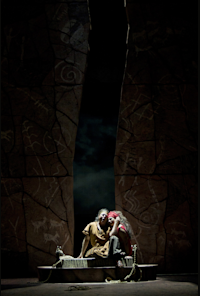Aida is an opera in four acts and seven scenes, in which Verdi was at least subconsciously, if not openly, inspired by the format of the French grand opera (fr. grand opéra), in which luxurious dances (ballet ) points. The opera libretto is said to have been written by Antonio Ghislanzoni based on a draft by Egyptologist François Auguste Mariette, although there is still some ambiguity surrounding the literary proposal. In particular, it is not known exactly who the real author of the draft is, either the aforementioned Egyptologist and archaeologist Mariette, who submitted the libretto to Verdi's friend Camillo du Loclo, or Mariette's brother Eduard, who accompanied his brother around Egypt in 1866, collecting documentary material for the exhibition in 1867, and who claims to be the true writer of the draft. There is also a fourth possibility of authorship for the name,
however, from Camilla du Locla's French text, Antonio Ghislanzoni (1824–1893), a former baritone, publisher of the Milan music journal Gazetta musicale, and prolific arranger of opera librettos, translated the work into Italian, and Verdi participated in its final form. The opera was commissioned by the Egyptian viceroy Ismail Pasha for the ceremonies at the opening of the Suez Canal in 1870, but the premiere was delayed for more than a year due to the German-French war. On December 24, 1871, Aida was only performed with enormous success and soon became one of Verdi's most popular works and one of the most popular operas in the world repertoire in general. After she had already toured all the world's stages, in 1912 she shone in a new light at the foot of the pyramids outdoors.
Aida is rightly one of Verdi's most important works. The composer designed it in large compositions, i.e. in convincing musical dramaturgical configurations with effective escalations and above all with subtle musical contrasting between emotionally intimate and social, heroic or public. The fact that it encroached both temporally and spatially on the ancient basin of the African Nile brought more than just passing interest to the European cultural context. With new harmonic consonances and a theme that was supposed to be based on the local colors of the banks of the Nile, Verdi conjured an exoticism that was attractive to the audience of the time (and also the present) from the first moment. More consistently than in his earlier musical theater works, Verdi exploited the possibilities of the leading motif that recurs throughout the opera, when a specific person appears or a specific situation occurs. The prelude of the opera is based on the motif of Aida as the titular "heroine", the chosen one of Radamès' heart, an Ethiopian slave in Egyptian captivity; the motif of the pharaoh's daughter Amneris, who is also in love with Radamès, is the second most important musical idea. The motif of jealousy is repeated several times, interspersed with countless wonderful melodic inventions, from Radamès's romance to Aida in the first act (Celeste Aida), Aida's heroic-longing aria Ritorna vincitor (from the end of the first act), through the triumphal fanfares of the second act until the final duet in the fourth act, when Aida and Radamès, embraced in the tomb, bid farewell to the world in their last moments together. otherwise Ethiopian slaves in Egyptian captivity, elephants prelude to the opera; the motif of the pharaoh's daughter Amneris, who is also in love with Radamès, is the second most important musical idea. The motif of jealousy is repeated several times, interspersed with countless wonderful melodic inventions, from Radamès's romance to Aida in the first act (Celeste Aida), Aida's heroic-longing aria Ritorna vincitor (from the end of the first act), through the triumphal fanfares of the second act until the final duet in the fourth act, when Aida and Radamès, embraced in the tomb, bid farewell to the world in their last moments together. otherwise Ethiopian slaves in Egyptian captivity, elephants prelude to the opera; the motif of the pharaoh's daughter Amneris, who is also in love with Radamès, is the second most important musical idea. The motif of jealousy is repeated several times, interspersed with countless wonderful melodic inventions, from Radamès's romance to Aida in the first act (Celeste Aida), Aida's heroic-longing aria Ritorna vincitor (from the end of the first act), through the triumphal fanfares of the second act until the final duet in the fourth act, when Aida and Radamès, embraced in the tomb, bid farewell to the world in their last moments together.


